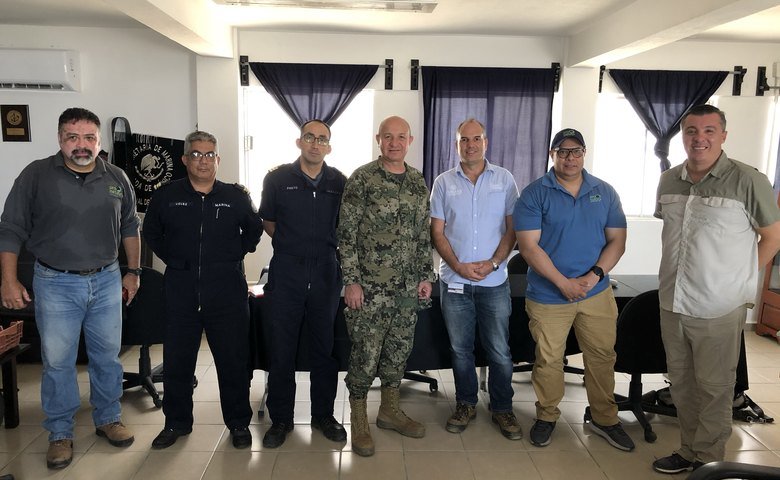Islas Marias National Marine Park: 2023 Progress Report
Introduction to Islas Marías Biosphere Reserve
Islas Marías Biosphere Reserve (IMBP) is part of the UNESCO "Islands and Protected Areas of the Gulf of California, located 100 km in front of the Nayarit coastline, covering 641,283 hectares (mostly marine) and four major islands. The entire Biosphere Reserve is a No-Take zone and constitutes one of Mexico’s highest priorities to protect marine ecosystems through the deployment of Global Park Defense (GPD).
Global Conservation's Marine Protection Progress
The Mexican Government invited GC to assist with Global Park Defense for Marine Protection, which includes deploying marine monitors, EarthRanger protection systems, Rapid Response Teams, and reserve-wide communications.
GC has made solid progress in 2022 and 2023 since GC Board approval and receiving our first grant from the Mary Jameson Foundation, including:
Hiring a full-time director to coordinate and deploy Global Park Defense in Mexico, focused on Islas Marias and Baja Sur from Loreto to Eastscape.
Established direct communications with all leaders of Isla Marias and are now reviewing a Collaboration Agreement with CONANP and the new Director of IMBR.
The IMBR Director has signed an Intention Letter to Global Conservation.
Signing a National Collaboration Agreement between CONANP and GC.
Islas Marías Biosphere Reserve. Green polygon indicates marine reserve.
Islas Marias has been an intensive fishing area for both illegal fishers coming from Nayarit and Jalisco. With the creation of a clear 2-mile No-Take Zone, the Islas Marias Reserve Authorities must now conduct surveillance and monitoring to protect over 641,284 hectares and nearly 240 miles of coastline. During patrols, rangers observed that illegal fishing is taking place throughout the marine reserve due to the lack of enforcement capacity along the marine reserve.
Implementing Global Park Defense for Marine Deployment
Our main goal is to deploy a Marine Park Defense (MPD) strategy on Islas Marias, improving and promoting effective enforcement for the entire No Take Zone against illegal fishing and other irregular activities.
MPD's technological components improve detection and protection skills and capacities, ranging from CONANP to promoting effective collaboration with the Mexican Navy (SEMAR) and providing training and expertise to our local partners.
GPD's technological components will allow for rapid detection and protection, as well as promote effective collaboration with the Mexican Navy. In addition to radar systems, vessels, motors, and patrol support, Global Conservation will provide continual training and expertise together with our local partners.
GC Partners and authorities routinely find active poachers, launch boats, and then force the poachers' boats to land, where they are approached by the authorities.
Illegal fishing is dominant in the South and North Islands. On our first missions to Islas Marias, we saw many illegal fishing boats (artisanal and sport fish) in the waters off these islands. Together with local partner Pronatura Noroeste A.C. we began a joint Global Park Defense program with CONANP and the Mexican Navy (SEMAR), including the installation of Marine Monitor (M2) systems and the real-time EarthRanger park protection system.
Biosphere Reserve managers & authorities are great partners for Global Conservation and have a proactive willingness to protect the reserve, improve surveillance, strengthen marine protection along the archipelago and stop illegal fishing. In Fall 2023, a MoU was signed to provide a framework for collaboration, and in Winter 2024, the first Marine Monitor (M2) was shipped out for installation on the North Island.
The Islas Marias Biosphere Reserve (IMBR) teams were given access to technology resources and lessons learned by Global Conservation and Pronatura Noroeste, which are currently being used for global marine protection, particularly in the Gulf of California.
The Global Park Defense for Marine Protection includes:
Marine Monitor Radars (M2)
Long-Range Cameras
AIS Antennas
EarthRanger Protection System
Skylight VMS and Satellite Vessel Tracking
Park-wide Communications
Marine Patrol Support: Fuel and Maintenance
Monitoring and Control Room
After threat evaluation, visits to the field, and selection of potential sites to deploy our first Marine Monitor, with the support of ProtectedSeas, a viewshed analysis was carried out that considered sites in San Juanito, Isla Madre, and Cleophas Island.
As a result of this first assessment of security, accessibility, and maintenance issues, among others, our first M2 radar will be deployed in the north portion of Isla Maria Madre on the top of an ancient surveillance building named Mirador Guayacanes.
Global Park Defense for Marine Deployment in 2024 includes:
One Marine Monitor M2 – North Island
One Marine Monitor M2 – South Island
Command & Control Room
Equipment & Communication
Additional Vessel and Motors
Training, expertise and guidance to IMBR rangers
















